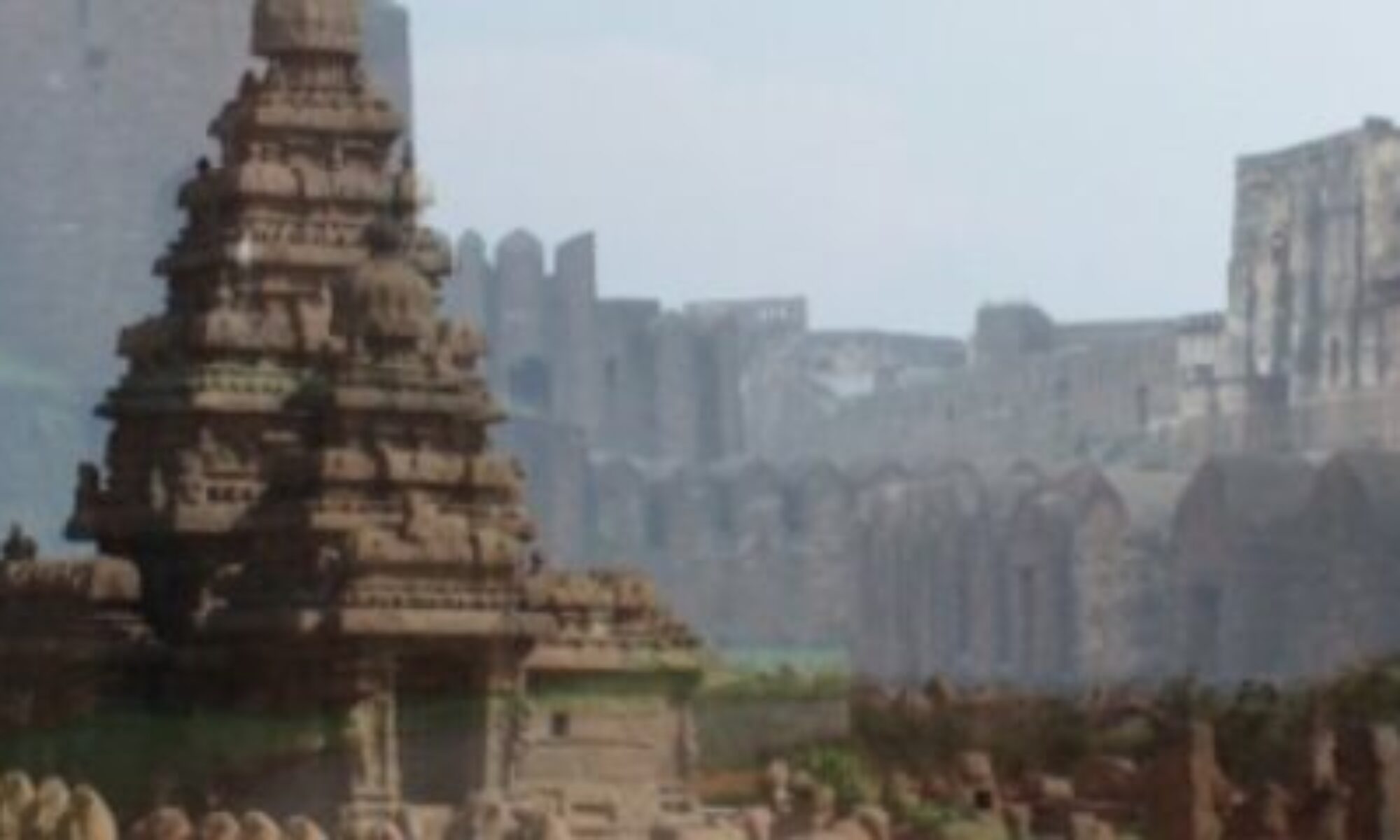This group of caves consists of a large chaitya and several viharas, some of which are now in ruins. The cave of Karla is certainly the largest, as well as the most complete Chaitya caves in India, and was excavated at a time when the style was in its greatest purity, and is fortunately the best preserved. Also, it was observed by J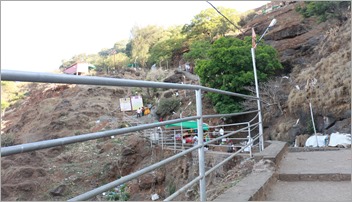 ames Ferguson that all the architectural defects of of the previous examples are removed. It is described in one of its own inscriptions as the most excellent rock mansions in Jambudwipa. One chaitya and nine viharas were excavated in this rock, however the chaitya is the most preserved.
ames Ferguson that all the architectural defects of of the previous examples are removed. It is described in one of its own inscriptions as the most excellent rock mansions in Jambudwipa. One chaitya and nine viharas were excavated in this rock, however the chaitya is the most preserved.
The caves are reached through the Pune-Mumbai highway taking a detour to the right for around 5 kilometers inside. A motor-able path through a hill takes to the base of the hill in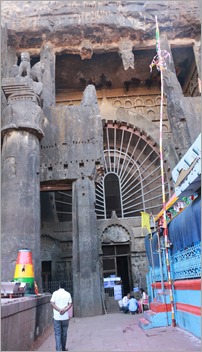 which the caves are carved. From the base, it is a around 200 steps of various height take near the caves.
which the caves are carved. From the base, it is a around 200 steps of various height take near the caves.
Let us talk about the chaitya now. There were originally two free-standing pillars, one on each side of the façade and slightly in advance of the entrance. These lion pillars were at least 15 meters in height, equaling that of the Asoka pillar at Sarnath. Their great size must have stuck the imagination of worshippers and were an imposing introduction to the wonders within. 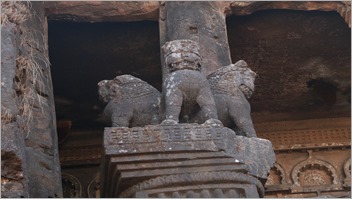 The pillar on the right was destroyed when the fault in the rock damaged the right side of the frontage. This other pillar may have supported the dharma chakra or the wheel. The temple of Ekavira now occupies the place where this pillar stood. The plain tapering 16 sided pillar stands on a wide cylindrical base, surmounted by a bell-shaped capital on which were four lions supporting a wheel, probably of metal.
The pillar on the right was destroyed when the fault in the rock damaged the right side of the frontage. This other pillar may have supported the dharma chakra or the wheel. The temple of Ekavira now occupies the place where this pillar stood. The plain tapering 16 sided pillar stands on a wide cylindrical base, surmounted by a bell-shaped capital on which were four lions supporting a wheel, probably of metal.
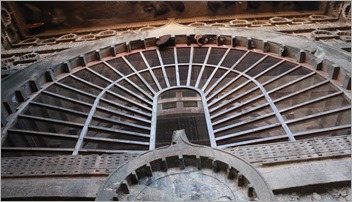 The outer porch is 52 feet wide and 15 feet deep. It is made up of two thick plain octagonal pillars without bas
The outer porch is 52 feet wide and 15 feet deep. It is made up of two thick plain octagonal pillars without bas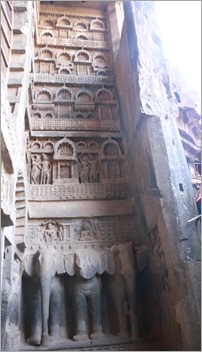 es and capitals, forming a triple entrance and supports a mass of rock in which are four pillars between pilasters that gave the effect of a dwarf colonnade above. Originally the fronts of three elephants in each end wall supported a frieze ornamented with a rail pattern, but at both ends this has been cut away to introduce figures somewhere around the 5th century. Above this was a thick quadrantal molding and then a rail with small facades of temples and pairs of figures. In the space between these upper and lower openings of the screen, numerous mortise holes exist for the attachment of a wooden gallery, which extended right across the front.
es and capitals, forming a triple entrance and supports a mass of rock in which are four pillars between pilasters that gave the effect of a dwarf colonnade above. Originally the fronts of three elephants in each end wall supported a frieze ornamented with a rail pattern, but at both ends this has been cut away to introduce figures somewhere around the 5th century. Above this was a thick quadrantal molding and then a rail with small facades of temples and pairs of figures. In the space between these upper and lower openings of the screen, numerous mortise holes exist for the attachment of a wooden gallery, which extended right across the front.
Beyond the rock-cut screen is th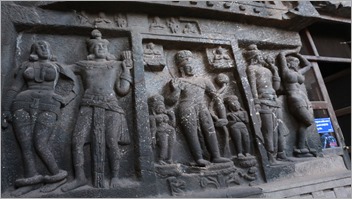 e façade decorated with chaitya arches, sculptured figures and dominated by the chaitya window. The chaitya arch occupies the greater part of the inner wall within which the window is recessed. Portions of the wooden transoms still remain, but the lower portion with its semi-circular lattice is missing. The panels of elephants, half size and in high relief are a particularly artistic decoration.
e façade decorated with chaitya arches, sculptured figures and dominated by the chaitya window. The chaitya arch occupies the greater part of the inner wall within which the window is recessed. Portions of the wooden transoms still remain, but the lower portion with its semi-circular lattice is missing. The panels of elephants, half size and in high relief are a particularly artistic decoration.
As i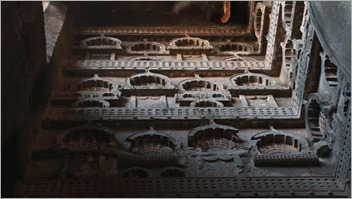 n most of the Hinayana caves, this chaitya had also been modified with the advent of Mahayana. The frieze above the elephants was cut away to insert figures of Buddha and his attendants. In this process, some of the older inscriptions have been cut away. The couples on either side of the door however appear to be part of the original decoration (Oven Kail compares this chaitya with the one at Kanheri). In the middle of the space between the central and
n most of the Hinayana caves, this chaitya had also been modified with the advent of Mahayana. The frieze above the elephants was cut away to insert figures of Buddha and his attendants. In this process, some of the older inscriptions have been cut away. The couples on either side of the door however appear to be part of the original decoration (Oven Kail compares this chaitya with the one at Kanheri). In the middle of the space between the central and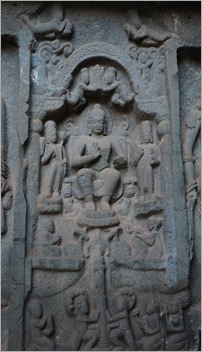 right door is a later insertion of the Buddha attended by Padmapani and Manjushri – The Buddha seated on a Lion throne, with feet on a lotus, over a wheel supported by two deer. There are naga figures beneath the wheel and above the Buddha are two attendants holding a crown.
right door is a later insertion of the Buddha attended by Padmapani and Manjushri – The Buddha seated on a Lion throne, with feet on a lotus, over a wheel supported by two deer. There are naga figures beneath the wheel and above the Buddha are two attendants holding a crown.
The entrance to the chaitya hall consisted of three doorways, the central door being reserved for priests and others for standing. The floor of the porch on either side of the central door was sunk to form shallow dips, and the laity stepped through these pools of water on their way to the side doors.
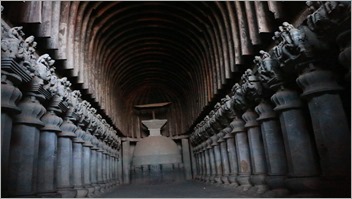 The inner hall is majestic. Two Thousand Two Hundred years have passed since chanting of saffron-robed monks broke the silence of his pillared hall. Its interior dimensions are 124 feet in total length and breadth from wall to wall is 45 feet while the width of the central aisle is 25 feet. The height is only 46 feet from the floor to the apex. The building resembles an early Christian chu
The inner hall is majestic. Two Thousand Two Hundred years have passed since chanting of saffron-robed monks broke the silence of his pillared hall. Its interior dimensions are 124 feet in total length and breadth from wall to wall is 45 feet while the width of the central aisle is 25 feet. The height is only 46 feet from the floor to the apex. The building resembles an early Christian chu rch in its arrangements. The nave is separated from the side aisles by fifteen columns with octagonal shafts on each side, of good design and workmanship. On the abacus which crowns the capital of each of these are two kneeling elephants, and on each elephant are two seated figures, generally a male and female, with their arms over each other’s shoulders, but sometimes two female figures in the same attitude. On the inner side, that is, within the aisles, ho
rch in its arrangements. The nave is separated from the side aisles by fifteen columns with octagonal shafts on each side, of good design and workmanship. On the abacus which crowns the capital of each of these are two kneeling elephants, and on each elephant are two seated figures, generally a male and female, with their arms over each other’s shoulders, but sometimes two female figures in the same attitude. On the inner side, that is, within the aisles, ho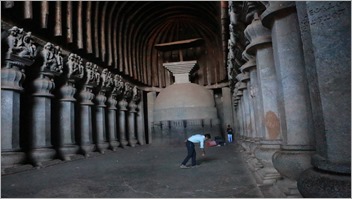 rses take the place of the elephants. Alternatively, you can also find bulls in place of horses on some of them. The eighth pillar on the right is sixteen-sided and has a dagoba carved on it, flanked by a chakra symbol and a sinha-sthambha. The seven pillars behind the dagoba are the usual plan octagonal ones, but the four pillars under the entrance gallery differ considerably from all others.
rses take the place of the elephants. Alternatively, you can also find bulls in place of horses on some of them. The eighth pillar on the right is sixteen-sided and has a dagoba carved on it, flanked by a chakra symbol and a sinha-sthambha. The seven pillars behind the dagoba are the usual plan octagonal ones, but the four pillars under the entrance gallery differ considerably from all others.
The wooden ribs of the roof, too, remain nearly entire, proving beyond doubt that the roof is not a copy of masonry arch. However, we can infer that the wooden ribs must have 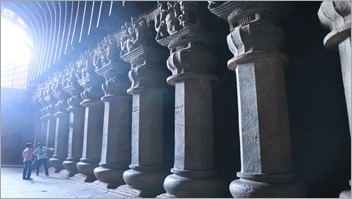 been renewed from time to time as the condition of the wood is still good. The roof looks tilted at the sides, so as to make the height greater than the semi-diameter.
been renewed from time to time as the condition of the wood is still good. The roof looks tilted at the sides, so as to make the height greater than the semi-diameter.
The framed screen, filling up a portion of the great arch in front, like the centering of the arch of a bridge, remains. It consists of two plan octagonal columns with pilasters. Over these is a deep plain mass of wall, occupy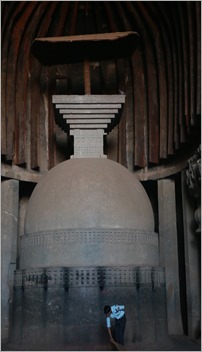 ing the place of an entablature, and over this again a superstructure of four dwarf pillars. Except the lower piers, the whole of this was covered with wooden ornaments. The design appears to have consisted of a broad balcony in front of the plain wall, supported by bold wooden brackets from the two piers. This was the music gallery or the Naqhar Khana, which we still find existing in front of all Jain temples. There are no traces of painting in this cave, but the cave has been inhabited, an
ing the place of an entablature, and over this again a superstructure of four dwarf pillars. Except the lower piers, the whole of this was covered with wooden ornaments. The design appears to have consisted of a broad balcony in front of the plain wall, supported by bold wooden brackets from the two piers. This was the music gallery or the Naqhar Khana, which we still find existing in front of all Jain temples. There are no traces of painting in this cave, but the cave has been inhabited, an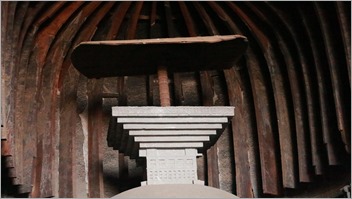 d smoke of cooking fire has blackened the plaster. Its inhabitants were Saivites, and the cave was considered a temple dedicated to Siva, the dagoba performing the part of a gigantic lingam.
d smoke of cooking fire has blackened the plaster. Its inhabitants were Saivites, and the cave was considered a temple dedicated to Siva, the dagoba performing the part of a gigantic lingam.
The dagoba is plan and very similar to that in Ajanta, but here a part of the wooden umbrella remains. It consists of a two storeyed dru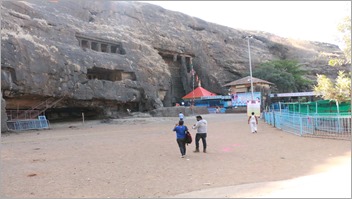 m with the rail pattern on the upper edge. There are sockets in the drum each of six inches depth which could be repositories of caskets containing relics. We can also presume that these are for fastening of a covering or a woodwork frame, which probably support ornamental hangings. The underside of the wooden umbrella is carved with a delicate pattern including a lotus. In the capital near the right corner is a recess covered with a rectangular stone slab. In the top of the capital, near the north-west corner, is a hole about ten inches deep, covered by a slab about ten inches square and four inches thick. It is beyond doubt that
m with the rail pattern on the upper edge. There are sockets in the drum each of six inches depth which could be repositories of caskets containing relics. We can also presume that these are for fastening of a covering or a woodwork frame, which probably support ornamental hangings. The underside of the wooden umbrella is carved with a delicate pattern including a lotus. In the capital near the right corner is a recess covered with a rectangular stone slab. In the top of the capital, near the north-west corner, is a hole about ten inches deep, covered by a slab about ten inches square and four inches thick. It is beyond doubt that 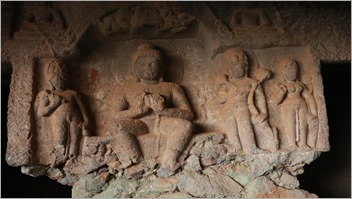 this was the receptacle of the relic.
this was the receptacle of the relic.
The remaining excavations at Karla are mostly cells, plain viharas of which only a few of the adjoining cells have benches and cisterns. Some of the early viharas were modified after the Mahayana advent, probably in the sixth or the seventh centuries, and embellished with figures of Buddha, Bodhisattva with female attendants. To provide additional accommodation, several of the vi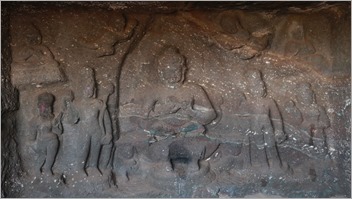 haras were excavated at different levels, which gave them the appearance of being storied, but all the viharas at Karla are overshadowed by the great chaitya.
haras were excavated at different levels, which gave them the appearance of being storied, but all the viharas at Karla are overshadowed by the great chaitya.
Of the viharas which deserve mention is the upper part of Cave 2 to the left of the chaitya. The entrances of the attached cells were not only fitted with wooden doors, but each cell could be isolated from the others by a sort of screen or curtain. Caves 6 and 11 are original Mahayana excavations, the former approachable by a staircase through Cave 5. On the rear and 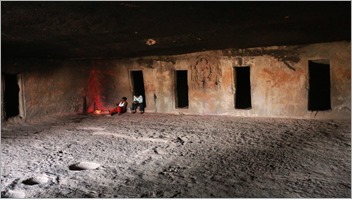 right walls are standing figures of Buddha, evidently of much later workmanship than the cave. Further north is another vihara which is about 38 feet long and 17 feet deep., with two cells at each
right walls are standing figures of Buddha, evidently of much later workmanship than the cave. Further north is another vihara which is about 38 feet long and 17 feet deep., with two cells at each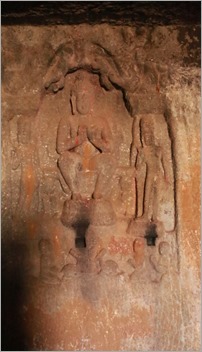 end and four in the back, out of which five have stone beds.
end and four in the back, out of which five have stone beds.
A reference has already been made of the temple dedicated to Goddess Ekavira, which is said to have been rebuilt in 1866. However, it seems that the goddess figure itself is older than the great chaitya. The image of the goddess is carved out of the rock behind. An interesting fact of the worship in this temple is that the music in the Naqarkhana was and is played by the barber community of Pune and has been since the Peshwa times. There were eleven men, two of them masters or jamadars and they play four times a day. The instruments are two big brass drums called nagadas, and two small iron drums called jilis, two brass trumpets, and a brass gong stuck by a wooden 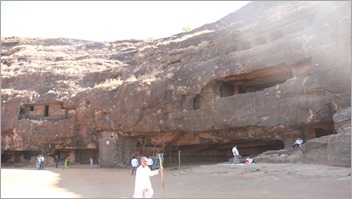 mallet, a pair of cymbals made of bell-metal and two wooden shehnais.
mallet, a pair of cymbals made of bell-metal and two wooden shehnais.
The village of Vehargaon (vihar-gaon) near Karla, so called because of the monasteries nearby and the town of Lonavla (earlier called Lenauli), which means the abundance of lenas or caves, are strong indications that this area, which includes Bhaja and Bedsa, was a stronghold of Buddhism with Karla as the center of pilgrimage.
Around 22 inscriptions have been located in these caves, which will be discussed in the next post.
References:
1. A Handbook to India, Pakistan, Burma and Ceylon, Originally written by John Murray.
2. Buddhist Cave Temples of India by Owen.C.Kail
3. Cave Temples of India by James Fergusson and James Burgess.
4. Gazetteer of the Bombay Presidency, Volume 28, Part 3 by James.M. Campbell
